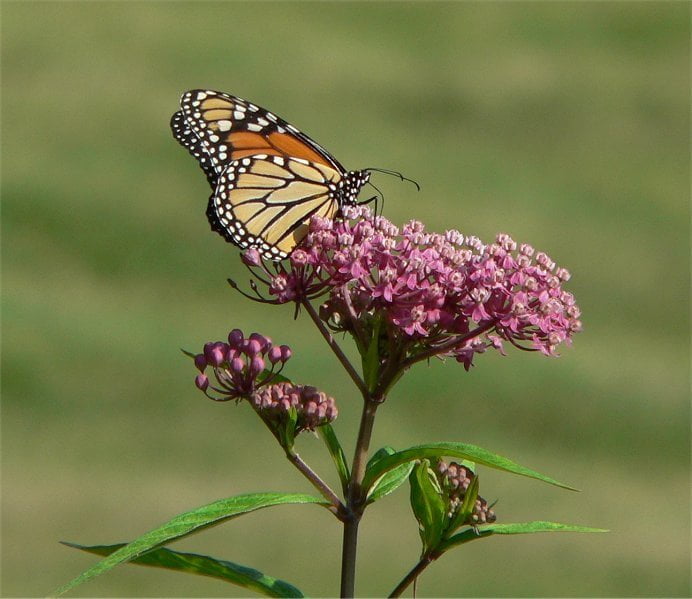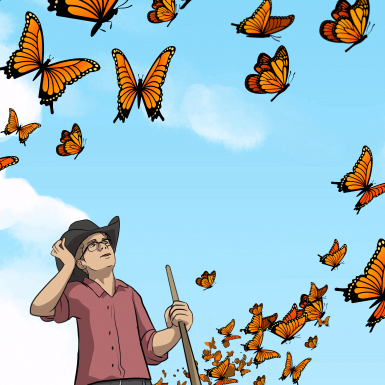The Monarch Butterfly (danaus plexippus) is at the very heart of Johnny Butterflyseed’s operations. Johnny learned that having Monarchs near you is as simple as growing the Monarch’s Larval Host Plant from the Milkweed (Asclepias) genus, and waiting for the Monarch eggs to roll in. He found this effect was usually immediate during the Monarch season. In fact, some Monarch females will zoom in for “window shopping” while Johnny is still digging a hole for the Milkweed.
As it turns out, the Monarch cannot lay eggs without Milkweed.
Milkweed
SPOILER ALERT: To have Monarchs, one must simply grow Milkweed plants.

Many express concern for the Monarch butterfly, but very few grow Milkweed in effort to increase Monarch populations. This fact is heartbreaking to Johnny. Milkweed is so easy to grow, that they went ahead and included “weed” right there in its name.
Wherever you are in North America, you can find native Milkweed, from “common” to endangered, and you will receive Monarch butterflies in return. Seems like a good trade. In fact, Johnny has learned to follow Monarch Butterflies to find nearby Milkweed, because as sure as the Monarch is there, so is the Milkweed. Both the Monarch and the Milkweed are inseparable miracles.
Miraculousness
The Monarch Butterfly is nothing short of dozens of individual miracles. From the use of latex (milk) from Milkweed as a defense, to caterpillars of various sizes working together to share common leaf resources (and sometimes butting heads in the process), to the huge migration distances they can achieve, Monarchs are a nearly endless string of seemingly impossible miracles working together to create one of the most unique and well-known bugs in North America. To directly observe the miraculous effect of a “Higher Power,” look no further than the lifecycle of the Monarch Butterfly.
Observe
Johnny recommends learning everything possible about the Monarch Butterfly, and then some of the impossible. The more that people know about caring for Monarchs, the more Monarchs will be appreciated, valued, and their populations will be expanded. A single Milkweed grown on a high rise balcony, or a Milkweed crop grown in multiple plowed rows on the “back forty”; Milkweed can be and should be grown anywhere.
And once Milkweed is growing, the best thing everyone can do is observe.Observe the eggs being laid, then hatching. Observe the caterpillars work their way around the leaves like lumberjacks, observe them crawl sometimes hundreds of feet to find that perfect place for a chrysalis. Plant, grow, and observe just like a farmer would their crops.
Butterfly Farming
Critical to the restoration of Monarch Butterflies across all of North America will be the mindset of Butterfly Farming.
“Anyone who creates and maintains sustainable butterfly habitats with Milkweed and nectar plants in order to help the Monarchs live and migrate is a Butterfly Farmer. It’s not a business; it’s a mission!”
-Johnny Butterflyseed
From families, to farmers, to foresters, Johnny hopes everyone will do their Butterfly Farming chores, and grow Monarch Butterflies.
PDF Resources
- Monarch Fact Sheet (USFWS)
- United States Department of AgricultureConservation and Management of Monarch Butterflies (USDA)
- Monarch ButterfIy Manual for the Environmental Educator
- Monarch Declared “At-Risk” in South Carolina
Restoration Success
“Restoration” is the goal of our work with Monarch Butterflies. While the successful restoration of the Monarch Butterfly can, and will be, defined by a specific set of parameters including population counts, and various other statistics, true restoration of the Monarch will require full restoration of the original Monarch Butterfly Habitat, which includes millions of acres of Longleaf Pine forest in the southeastern United States, a forest which was greedily clear-cut without any sort of restoration or management plan. Almost none of the pines were spared, those spared were on islands or other extremely difficult areas to clear cut.
Johnny cannot and will not consider Monarchs restored until all of the Longleaf Pine forest has been restored. Unfortunately, this goal is quite literally hundreds of years away from the start of a real reforestation of the Longleaf Pine savannas of southeastern United States. But this does not mean we shouldn’t start as soon as possible. If Johnny has learned anything, its that those hundreds of years will pass by regardless, so let’s just get started.
